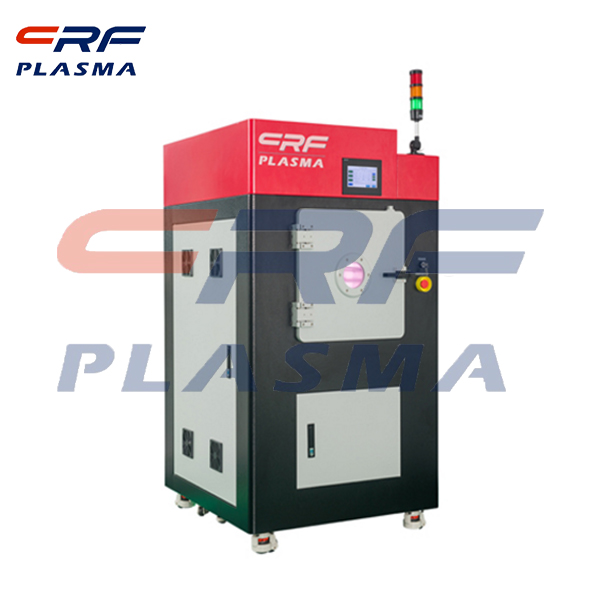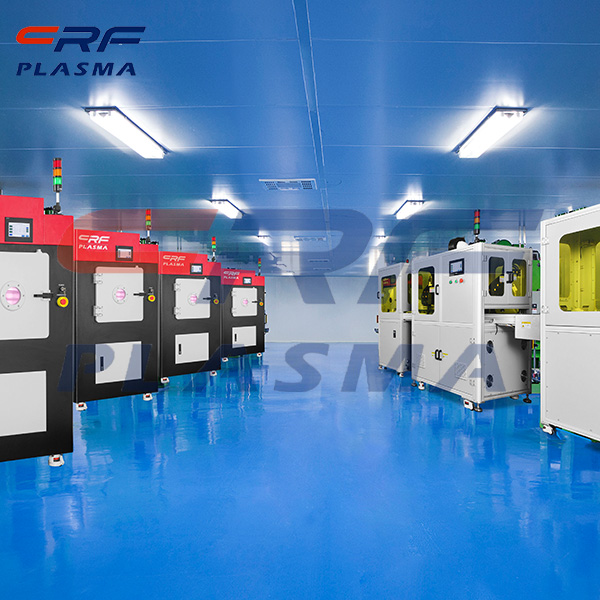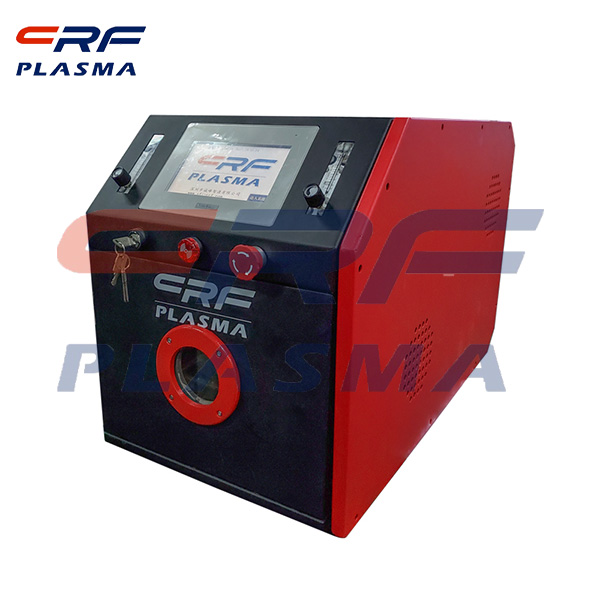
Welcome to Shenzhen Sing Fung Intelligent Manufacturing Co., Ltd.
E-mail:shaobo@sfi-crf.com
Silicon carbide oxygen plasma surface treatment
- Categories:Industry News
- Author:plasma cleaning machine-surface treatment equipment-CRF plasma machine-Sing Fung Intelligent Manufacturing
- Origin:
- Time of issue:2020-11-19
- Views:
(Summary description)Compared with other high temperature materials, silicon carbide has lower average thermal expansion coefficient, higher thermal conductivity and better ultra-high temperature resistance performance, so it has a broad application prospect in high frequency, high power, high temperature resistance, radiation resistance semiconductor devices and ULTRAVIOLET detectors. Bonding is a very important step in silicon carbide micromachining and MEMS technology, and also one of the difficult problems in manufacturing industry. As for the direct bonding of silicon carbide, the problems of mismatching of thermal expansion coefficient and electrical properties when different materials are connected under high temperature environment are solved, and the isomer of silicon carbide can be directly combined together to form heterojunction devices. Heterojunction has many advantages over homogeneous junction. For example, compared with schottky transistors, heterojunction fET can obtain lower leakage current. Heterojunction bipolar transistors can improve emission efficiency, reduce base resistance, improve frequency response, and have a wide operating temperature range. Among them, the surface treatment is a key factor in the direct bonding and its treatment effect is good or bad will directly affect the bonding can occur, and the interface effect, after the bonding because pollutants adsorption on the chip surface, the wafer surface roughness, etc., will cause the bonding hole, and the mechanical properties and electrical properties of the chip surface varying degrees of impact. At present, the surface treatment methods of silicon carbide mainly include traditional wet treatment, high temperature annealing and plasma treatment. The traditional wet washing treatment is developed from the wet process of silicon, which mainly includes HF method and RCA method, each of which has its own characteristics. For example, the wet treatment steps are simple, but the results include pollutants like C, O, and F; High temperature treatment can effectively remove C and O pollutants, but the treatment temperature needs to be further optimized and the subsequent process compatibility is poor. Plasma treatment can effectively remove pollutants containing O and F, but improper treatment temperature and time will lead to ion damage to the surface, resulting in surface reconstruction of silicon carbide. According to the characteristics of the above surface treatment methods, the wafers were treated by wet cleaning, oxygen and argon plasma treatment, and the wafers were bonded directly with silicon carbide melting point at low temperature and low pressure by hot pressing method, and the ideal bonding effect was achieved. Plasma surface treatment equipment treatment: further treatment of plasma in practical applications can reduce the roughness of the chip, increase the activation degree of the chip, and obtain more suitable for direct bonding. It can be seen from the theory of binding to solid surface that when there are a lot of unsaturated bonds on the surface of the chip, the foreign is easy to bond to it. The surface hydrophilicity and adsorption properties of the chip can be changed by plasma treatment. Plasma surface excitation technology only changes the surface layer of the chip, but does not change the mechanical, electrical and mechanical properties of the material itself. The plasma treatment method has the characteristics of no pollution, simple process, fast speed and high efficiency. After many experiments, specific schemes of oxygen and argon treatment were obtained, and they were successfully applied in the subsequent bonding process. Oxygen and argon are polymerized gas, plasma interacts with silicon dioxide layer on the surface of the wafer, the activity of these atoms and high energy electron destroyed the original si-o bond structure, make it a key bridge, surface activation energy and leads to the electronic combination of excited atoms and can move to a higher, make its surface there are a lot of hanging key, and these key overhang and combined with OH groups form, form a stable structure. After the surface of SI-OH is soaked in organic or inorganic alkali and anneal at a certain temperature, the bonding bond is dehydrated and polymerized to form silicon-oxygen bond, which enhances the surface hydrophilicity of the chip and is more conducive to the bonding of the chip. The hydrophilic wafer surface is superior to the hydrophobic wafer surface in spontaneous bonding.
Silicon carbide oxygen plasma surface treatment
(Summary description)Compared with other high temperature materials, silicon carbide has lower average thermal expansion coefficient, higher thermal conductivity and better ultra-high temperature resistance performance, so it has a broad application prospect in high frequency, high power, high temperature resistance, radiation resistance semiconductor devices and ULTRAVIOLET detectors. Bonding is a very important step in silicon carbide micromachining and MEMS technology, and also one of the difficult problems in manufacturing industry. As for the direct bonding of silicon carbide, the problems of mismatching of thermal expansion coefficient and electrical properties when different materials are connected under high temperature environment are solved, and the isomer of silicon carbide can be directly combined together to form heterojunction devices. Heterojunction has many advantages over homogeneous junction. For example, compared with schottky transistors, heterojunction fET can obtain lower leakage current. Heterojunction bipolar transistors can improve emission efficiency, reduce base resistance, improve frequency response, and have a wide operating temperature range.
Among them, the surface treatment is a key factor in the direct bonding and its treatment effect is good or bad will directly affect the bonding can occur, and the interface effect, after the bonding because pollutants adsorption on the chip surface, the wafer surface roughness, etc., will cause the bonding hole, and the mechanical properties and electrical properties of the chip surface varying degrees of impact. At present, the surface treatment methods of silicon carbide mainly include traditional wet treatment, high temperature annealing and plasma treatment. The traditional wet washing treatment is developed from the wet process of silicon, which mainly includes HF method and RCA method, each of which has its own characteristics. For example, the wet treatment steps are simple, but the results include pollutants like C, O, and F; High temperature treatment can effectively remove C and O pollutants, but the treatment temperature needs to be further optimized and the subsequent process compatibility is poor. Plasma treatment can effectively remove pollutants containing O and F, but improper treatment temperature and time will lead to ion damage to the surface, resulting in surface reconstruction of silicon carbide. According to the characteristics of the above surface treatment methods, the wafers were treated by wet cleaning, oxygen and argon plasma treatment, and the wafers were bonded directly with silicon carbide melting point at low temperature and low pressure by hot pressing method, and the ideal bonding effect was achieved.
Plasma surface treatment equipment treatment: further treatment of plasma in practical applications can reduce the roughness of the chip, increase the activation degree of the chip, and obtain more suitable for direct bonding. It can be seen from the theory of binding to solid surface that when there are a lot of unsaturated bonds on the surface of the chip, the foreign is easy to bond to it. The surface hydrophilicity and adsorption properties of the chip can be changed by plasma treatment. Plasma surface excitation technology only changes the surface layer of the chip, but does not change the mechanical, electrical and mechanical properties of the material itself. The plasma treatment method has the characteristics of no pollution, simple process, fast speed and high efficiency. After many experiments, specific schemes of oxygen and argon treatment were obtained, and they were successfully applied in the subsequent bonding process. Oxygen and argon are polymerized gas, plasma interacts with silicon dioxide layer on the surface of the wafer, the activity of these atoms and high energy electron destroyed the original si-o bond structure, make it a key bridge, surface activation energy and leads to the electronic combination of excited atoms and can move to a higher, make its surface there are a lot of hanging key, and these key overhang and combined with OH groups form, form a stable structure. After the surface of SI-OH is soaked in organic or inorganic alkali and anneal at a certain temperature, the bonding bond is dehydrated and polymerized to form silicon-oxygen bond, which enhances the surface hydrophilicity of the chip and is more conducive to the bonding of the chip. The hydrophilic wafer surface is superior to the hydrophobic wafer surface in spontaneous bonding.
- Categories:Industry News
- Author:plasma cleaning machine-surface treatment equipment-CRF plasma machine-Sing Fung Intelligent Manufacturing
- Origin:
- Time of issue:2020-11-19 08:57
- Views:
Silicon carbide oxygen plasma surface treatment:
Compared with other high temperature materials, silicon carbide has lower average thermal expansion coefficient, higher thermal conductivity and better ultra-high temperature resistance performance, so it has a broad application prospect in high frequency, high power, high temperature resistance, radiation resistance semiconductor devices and ULTRAVIOLET detectors. Bonding is a very important step in silicon carbide micromachining and MEMS technology, and also one of the difficult problems in manufacturing industry. As for the direct bonding of silicon carbide, the problems of mismatching of thermal expansion coefficient and electrical properties when different materials are connected under high temperature environment are solved, and the isomer of silicon carbide can be directly combined together to form heterojunction devices. Heterojunction has many advantages over homogeneous junction. For example, compared with schottky transistors, heterojunction fET can obtain lower leakage current. Heterojunction bipolar transistors can improve emission efficiency, reduce base resistance, improve frequency response, and have a wide operating temperature range.
Among them, the surface treatment is a key factor in the direct bonding and its treatment effect is good or bad will directly affect the bonding can occur, and the interface effect, after the bonding because pollutants adsorption on the chip surface, the wafer surface roughness, etc., will cause the bonding hole, and the mechanical properties and electrical properties of the chip surface varying degrees of impact. At present, the surface treatment methods of silicon carbide mainly include traditional wet treatment, high temperature annealing and plasma treatment. The traditional wet washing treatment is developed from the wet process of silicon, which mainly includes HF method and RCA method, each of which has its own characteristics. For example, the wet treatment steps are simple, but the results include pollutants like C, O, and F; High temperature treatment can effectively remove C and O pollutants, but the treatment temperature needs to be further optimized and the subsequent process compatibility is poor. Plasma treatment can effectively remove pollutants containing O and F, but improper treatment temperature and time will lead to ion damage to the surface, resulting in surface reconstruction of silicon carbide. According to the characteristics of the above surface treatment methods, the wafers were treated by wet cleaning, oxygen and argon plasma treatment, and the wafers were bonded directly with silicon carbide melting point at low temperature and low pressure by hot pressing method, and the ideal bonding effect was achieved.
Plasma surface treatment equipment treatment: further treatment of plasma in practical applications can reduce the roughness of the chip, increase the activation degree of the chip, and obtain more suitable for direct bonding. It can be seen from the theory of binding to solid surface that when there are a lot of unsaturated bonds on the surface of the chip, the foreign is easy to bond to it. The surface hydrophilicity and adsorption properties of the chip can be changed by plasma treatment. Plasma surface excitation technology only changes the surface layer of the chip, but does not change the mechanical, electrical and mechanical properties of the material itself. The plasma treatment method has the characteristics of no pollution, simple process, fast speed and high efficiency. After many experiments, specific schemes of oxygen and argon treatment were obtained, and they were successfully applied in the subsequent bonding process. Oxygen and argon are polymerized gas, plasma interacts with silicon dioxide layer on the surface of the wafer, the activity of these atoms and high energy electron destroyed the original si-o bond structure, make it a key bridge, surface activation energy and leads to the electronic combination of excited atoms and can move to a higher, make its surface there are a lot of hanging key, and these key overhang and combined with OH groups form, form a stable structure. After the surface of SI-OH is soaked in organic or inorganic alkali and anneal at a certain temperature, the bonding bond is dehydrated and polymerized to form silicon-oxygen bond, which enhances the surface hydrophilicity of the chip and is more conducive to the bonding of the chip. The hydrophilic wafer surface is superior to the hydrophobic wafer surface in spontaneous bonding.

Scan the QR code to read on your phone

TEL:0755-3367 3020 / 0755-3367 3019

E-mail:sales-sfi@sfi-crf.com

ADD:Mabao Industrial Zone, Huangpu, Baoan District, Shenzhen


















